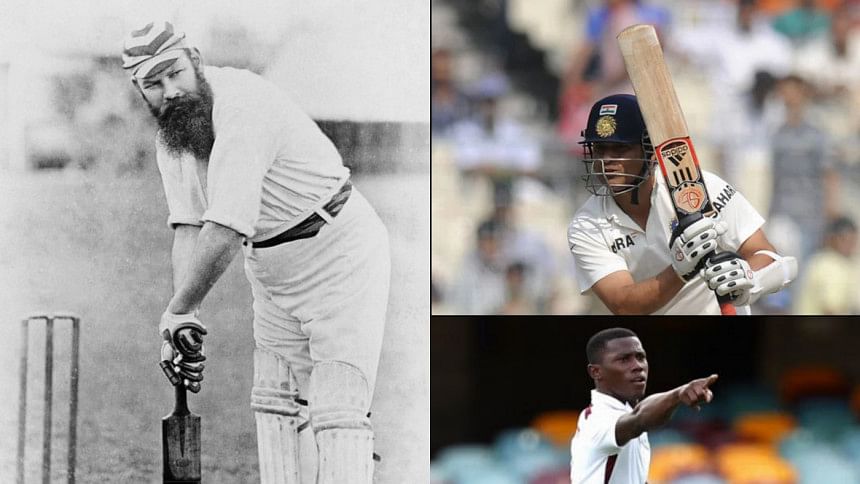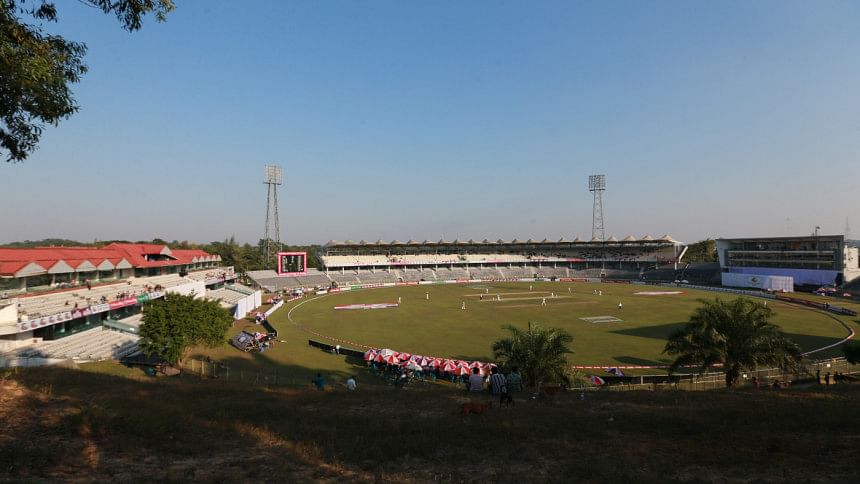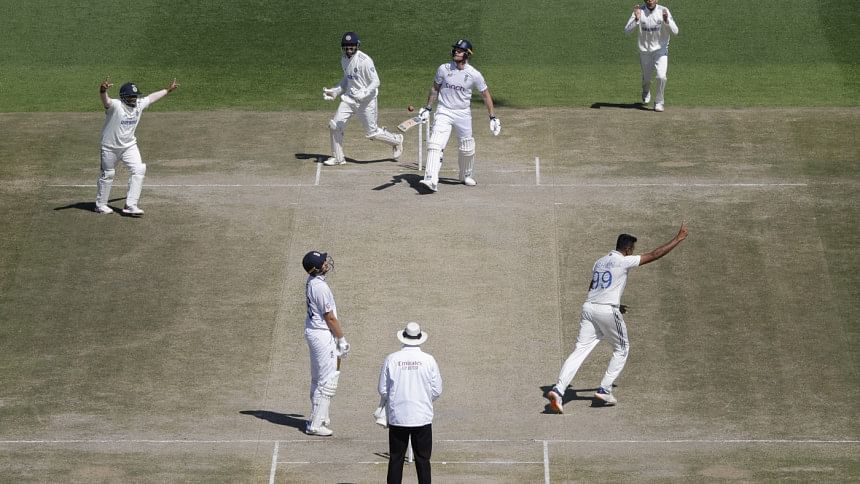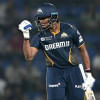Test cricket: A relic that refuses to perish

"The game was well contested, and the vanquished, I can assure you, did not grudge the conquerors the victory… The bowling of Ensign Ross, and Sepoy Soophul was as usual first rate in both matches."
Yesterday, the Bangladesh team's first Test of a two-match series against Sri Lanka began at the Sylhet International Cricket Stadium – a picturesque cricket ground in the northeastern part of the country.
Although Sylhet is a relatively new Test venue, having hosted just two other Test matches before the ongoing game, the region's history with the game itself is anything but new.
About 180 years ago, well, 179 years and 19 days to be exact, British magazine 'Sporting Intelligence' ran a report on its March 3, 1845, edition titled 'Sepoy Cricket at Sylhet', detailing a match between Captain Powell's Side and Ensign Ross's side in Sylhet.
This report and the scorecard attached with it is an important document in the history of cricket in the Indian sub-continent as it is the oldest recorded cricket match held in this part of the world.

Just to put it into context, that match was held 32 years before Australia's Charles Bannerman faced England's Alfred Shaw at the MCG in the first ball of the first Test match ever and just a year after the first-ever international cricket match was held in New York between the USA and Canada, two countries where cricket never quite caught on.
Cricket as a game has been around for much longer, with the earliest recorded cricket match being in the 16th century, albeit the rules of the game and the instruments of play would make it seem like an entirely different game to current cricket fans.
Till about the 1970s, Test was the only format of cricket, hence the evolution of the game and the format till then was one and the same.
Test cricket has survived the turn of two centuries and while many of its core traits have remained the same, it also has had to evolve with time.
The nascent days
Cricket first got some form of structure in 1744 when the laws of the game were first defined and then in 1788, the Marylebone Cricket Club (MCC) drafted the first printed edition of the laws of cricket.
Betting, something that remains a hot topic in cricket even today, played a significant role in increasing the game's popularity in its infancy in England as there are records of wealthy British Lords wagering huge sums on local cricket matches in the 17th century.
Some of the Lords even formed their own teams which kick-started the County Cricket system in England.
Cricket went beyond the British Isles and reached places like Australia, the Caribbean islands and the Indian sub-continent through British imperialist forces.
The British officers tried to use cricket as a 'civilising' tool among the local populace, encouraging local soldiers to take up the sport.
The aforementioned match in Sylhet is an apt example of it as several local soldiers, known as sepoys, named Salmon, Suphool, Sungum and Roostam took part in that match alongside British officers.

Gradually, cricket became a way for the colonised countries to get even with their colonisers, the British, and this was the starting point of international cricket.
Duration confusion
For most of the 20th century, there was no competition like a World Cup to determine which the best cricket playing country in the world is.
Even the number of days in a Test match was not set in stone for the longest time. Test matches in Australia were all timeless till 1939, but that wasn't the case in other countries as match durations varied from five to six days with a rest day in between after the second or third day.
In his book, 'Edging Towards Darkness: The Last Timeless Test', cricket writer John Lazenby said that there are a total of 99 timeless Tests, however, many of those matches would end within two to three days as the pitches during those times would not be as well looked after as those are now, making batting very difficult as the games progressed.
By the 1970s, most Test matches were five-day affairs, but there were two six-day Tests in that decade as well, the last of which was in 1978 between India and Australia in Adelaide.
In this century, there was only one six-day Test, which was between Australia and the ICC World XI in Sydney in 2005, a match that ended inside four days.
Enter limited-overs cricket
Cricket and Test cricket stopped being synonymous in 1971 with the arrival of limited-overs cricket.
The inaugural ICC Cricket World Cup was held in 1975, which was then called the Prudential Cup after the sponsor, but the world first saw the commercial scope of the ODI format with the Kerry Packer World Series Cricket in 1977.
By the 1980s and '90s, ODIs became more prevalent, with many countries hosting triangular and four- nation series.
Then in the mid-2000s came Twenty20s, the three-hour-long popcorn-munching, high-octane, slam-bang version of cricket.
In 2007, the Indian Premier League (IPL) came into the picture, and it was followed by numerous copycat leagues, rapidly changing the power dynamics in cricket as a whole.
The introduction of two more dynamic and time-efficient versions of the game, which were more in line with modern times, further highlighted the archaic nature of Tests.
Test cricket as a format was designed for British gentlemen of a bygone era who had the time to spend days playing a game which had breaks woven into it to take lunch and sip cups of tea in the afternoon.
This format has had to coincide with one-dayers for over half a century and with T20 for about two decades.
In all practicality, Tests should've been a relic by now, left behind in the ruins of the British empire. But that hasn't been the case.
Proving eulogies false for a century
Cricket purists had been predicting the doom of Test cricket even before limited-overs cricket had been a thing.
Former Aussie cricketer Jack Fingleton, for example, had predicted in 1969 that overseas cricketers going to England to play for County teams would lead to the death of Test cricket, saying, "International blood of other countries [would] be sucked dry by England in trying to keep alive the out-moded, incongruous county cricket system."
Interestingly, his admonishing tone towards County Cricket is similar to what many current pundits are saying about the many franchise T20 leagues, blaming them for ruining Test cricket.
The fear of losing Test cricket is almost as old as the format itself as even in 1912 the ICC, then called the Imperial Cricket Conference, arranged a tri-nation Test tournament between England, Australia and South Africa in England, fearing people were losing interest in the game.
With the introduction of 50-overs cricket and then the 20-overs format, those fears have only compounded.
But Test as a format has displayed fortitude and resilience – much like what it demands from the cricketers who take part in it – as it continues to be a format that enthrals millions across the world.
However, there is no doubt that Test cricket has had to take some hits along the way.
The five-Test series are now almost exclusive for series between Australia, India and England as teams like Bangladesh and Sri Lanka usually have to settle for two-match engagements.
The once fierce West Indies haven't had their best players available for selection for red-ball cricket for a while now as most of them prefer plying their trade in T20 franchise leagues instead.
Even South Africa recently sent a second-string side for a Test series to New Zealand because they reserved their best players for their local T20 league, SA20.
Test sides with rich histories like West Indies and South Africa sending second-string teams might seem like unique occurrences in Test cricket, but that's not entirely true.
In 1977, when the Kerry Packer World Series Cricket kicked off, the Australian cricket authorities banned every Aussie player who took part in the tournament and brought back 41-year-old Bob Simpson who had retired from the game a decade ago and named him the captain of a team of youngsters.
Australia carried on with that second-string team for over two years, playing Test series against India, West Indies, England and Pakistan, before the conflict ended.
Ironically, the absence of frontline players in the West Indies team made way for one of the most memorable moments in Test cricket in recent times when a young West Indian pacer named Shamar Joseph ripped apart the world champions Aussies in one spell and earned the Caribbean side their first Test win on Australian soil after 27 years in January this year.

Even the second-string South Africa side, which had seven uncapped players in the squad including captain Neil Brand, managed a first innings lead in the second Test against New Zealand before a Kane Williamson century knocked them out of the match.
The great divide
A problem in the current Test landscape is the great divide between the top Test sides – Australia, England and India – and the other teams, both in terms of quality and popularity.
On paper, nine more teams play Tests, but out of them Zimbabwe play the format sporadically while newcomers Ireland and Afghanistan hardly get any games.
There is a gulf of difference between the remaining six teams as well with New Zealand perhaps the strongest of the bunch currently and Bangladesh being the weakest.
This tangible difference between top teams and the rest prompted former England cricketer Kevin Pietersen to predict recently, "This is painful to tweet but I think this is slowly happening… In 2026 there
will only be a few Test Match cricketing nations. England, India, Australia, possibly South Africa and Pakistan."
But perhaps the scenario is not as bleak as Pietersen thinks.
Less draws, more results
ICC, for all the flak it has received for not taking enough steps to prioritise Test cricket, deserves its flowers for coming up with the ICC Test Championship, which has added stakes to every Test series, and increased the number of Tests for teams in the lower end of the spectrum like Bangladesh.
The ICC has also been arranging day/night Test since 2015 in an attempt to bring the allure of cricket under artificial lights to the longest format but it is still a work in progress.
In the last few years, 'Bazball' of the England team has been all the rage in Test cricket, with many hailing it for breathing life into a dying format while others are utterly unconvinced by its effectiveness.
Whether one buys into the 'Bazball' hype or not, what can't be denied is that it has generated extra buzz whenever England play a Test match. And the fearless batting, which is the hallmark of the philosophy, is the result of employing the white-ball mindset in the red-ball game.

England are also not the only team scoring at a quicker rate in Tests as run-rate overall has increased in Test cricket in recent years. And this attacking mindset, which is the direct byproduct of T20 cricket, has led to fewer draws.
The stats show that 14.20 percent of the Tests held in the eight years between 2016 to 2023 have ended in draws, which is much lower than the percentage of drawn Tests from 2000 to 2007, the year the T20 craze first began with T20 World Cup and the IPL, which is 23.40 percent.
In simpler terms, during 2000-2007, almost one out of every four Tests used to end in a draw, and in 2017-23, only one in seven Tests have ended without a victor.
Test cricket continues to evolve
This shift towards a more result-oriented approach in Tests can also be viewed as part of the format's evolution process, almost as if it is adapting itself to the new landscape of the game to ensure its survival.
Evolution is never a quick process and neither a visible one. It happens gradually, over the course of many years. The ability to evolve has saved Test cricket from the doom people have been envisioning for over a century.
The challenges for Test cricket are mounting and will continue to mount in the next few years. But Tests, most probably, will find a way to survive.
As for the match that took place in Sylhet around 180 years ago, Ensign Ross's team had won that tie with Sepoy Soophul leading the charge with the ball.
Hopefully, the Tigers will honour the legacy of Soophul and the many more unnamed cricketers who were the first to pick up a cricket ball and bat from this region with a win against Sri Lanka.

 For all latest news, follow The Daily Star's Google News channel.
For all latest news, follow The Daily Star's Google News channel. 








Comments